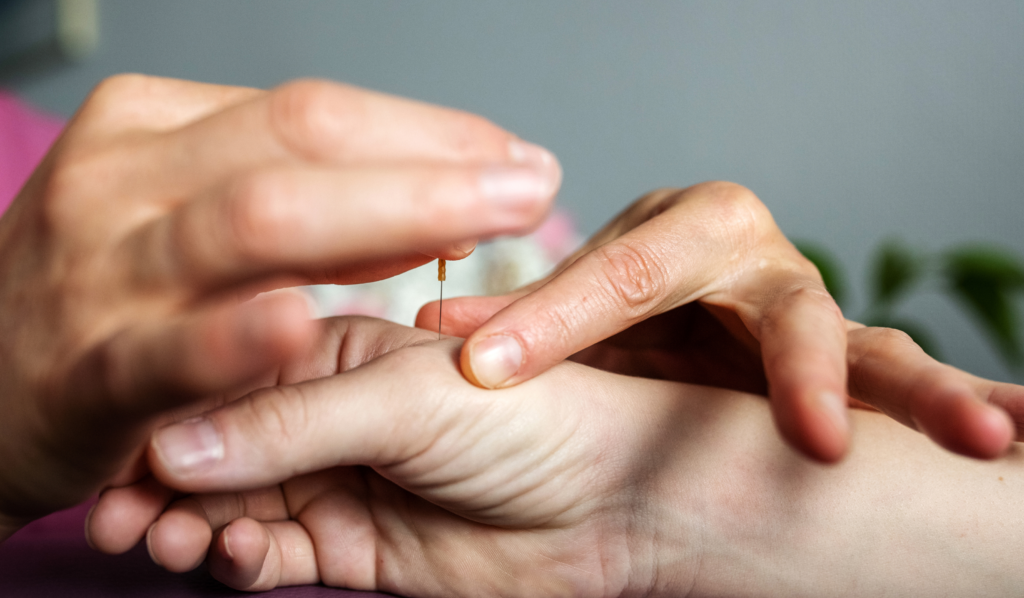Acupuncture Points for Cough Relief: A Traditional Chinese Medicine Approach
Coughing can be exhausting, making it difficult to focus, rest, or manage daily activities comfortably. More than just a reflex, it’s the body’s natural way of clearing irritants, mucus, or infections from the airways. When a cough persists, it can leave you feeling worn down, disrupt sleep, and make even everyday conversations uncomfortable. While over-the-counter medications might offer quick relief, they often only mask the symptoms instead of addressing the underlying cause.
In Traditional Chinese Medicine (TCM), a cough is seen as a sign of internal imbalance rather than an isolated issue. Whether it stems from seasonal changes, dryness, excess phlegm, or deeper respiratory concerns, acupuncture offers a natural path to support the body’s healing process. By stimulating specific acupuncture points, it helps to soothe throat irritation, clear congestion, and strengthen lung function for easier breathing. Embracing these natural approaches provides a more holistic way to manage a cough, promoting both immediate relief and long-term respiratory health beyond what conventional treatments typically offer.
Acupuncture Points for Cough Relief: A Traditional Chinese Medicine Approach
Coughing can be exhausting, making it difficult to focus, rest, or manage daily activities comfortably. More than just a reflex, it’s the body’s natural way of clearing irritants, mucus, or infections from the airways. When a cough persists, it can leave you feeling worn down, disrupt sleep, and make even everyday conversations uncomfortable. While over-the-counter medications might offer quick relief, they often only mask the symptoms instead of addressing the underlying cause.
In Traditional Chinese Medicine (TCM), a cough is seen as a sign of internal imbalance rather than an isolated issue. Whether it stems from seasonal changes, dryness, excess phlegm, or deeper respiratory concerns, acupuncture offers a natural path to support the body’s healing process. By stimulating specific acupuncture points, it helps to soothe throat irritation, clear congestion, and strengthen lung function for easier breathing. Embracing these natural approaches provides a more holistic way to manage a cough, promoting both immediate relief and long-term respiratory health beyond what conventional treatments typically offer.
Key Takeaways
- Acupuncture targets root imbalances in the body, not just symptoms, making it effective for treating both acute and chronic coughs in a holistic way.
- Specific points like LU7, LU5, ST40, and Dingchuan help clear phlegm, soothe throat irritation, and strengthen lung Qi for better breathing and less coughing.
- Cough types in TCM vary by pattern—such as dry, wet, spasmodic, or allergy-related—and treatment is tailored to address the underlying cause.
- Complementary therapies like cupping, herbal medicine, and Qigong breathing enhance the effects of acupuncture and promote long-term respiratory health.
- Lifestyle and environmental factors such as poor diet, stress, and pollution can worsen coughs, and addressing these is key to lasting relief and prevention.
How Acupuncture Helps Relieve Cough
Acupuncture is deeply rooted in the principle of restoring balance within the body, particularly by harmonizing the flow of Qi (energy). In Traditional Chinese Medicine (TCM), the lungs are not only responsible for breathing but are also closely connected to the body’s defensive energy, known as Wei Qi. This vital energy protects against external pathogens and maintains the proper function of the respiratory system.
When lung Qi becomes weakened or obstructed—whether from environmental factors like viruses, cold weather, or pollution, or from internal imbalances such as dryness or phlegm buildup—it disrupts the body’s ability to clear irritants efficiently. As a result, coughing develops as a signal that the body is trying to expel blockages and restore balance.
Acupuncture addresses this by targeting specific meridians and acupuncture points connected to the respiratory system. By gently inserting fine needles at these points, practitioners work to stimulate energy flow, clear blockages, and promote the body’s natural healing mechanisms. Over time, this helps reduce the intensity and frequency of coughing while supporting overall lung health.
Here’s how acupuncture provides relief from cough:
- Reduces throat irritation and inflammation: By calming inflamed tissues and soothing the throat lining, acupuncture alleviates the raw, scratchy sensation that often triggers coughing fits.
- Clears excess phlegm and mucus buildup: Certain points help regulate the body’s fluid metabolism and promote the clearance of dampness and phlegm that can congest the lungs.
- Strengthens lung Qi to prevent recurrent coughs: Strengthening the lungs’ energy reserves not only helps resolve the current cough but also fortifies the respiratory system against future imbalances and infections.
- Relaxes the chest muscles and eases breathing difficulties: Acupuncture promotes relaxation in the muscles surrounding the chest and diaphragm, making breathing smoother and reducing the spasms that lead to coughing.
In addition to direct symptom relief, acupuncture plays a preventive role by addressing the underlying causes of coughing. Whether dealing with a dry, lingering cough or one heavy with mucus, treatments are customized to your unique pattern of imbalance. This personalized approach means that you’re not just masking symptoms—you’re working toward lasting respiratory health.
At ACA Acupuncture & Wellness, we design treatments specifically to strengthen lung function, clear blockages, and support the body’s natural resilience, helping you breathe easier and recover more comfortably from persistent coughing.
Best Acupuncture Points for Cough Relief
1. LU7 (Lieque) – Strengthening the Lungs
Location: On the wrist, approximately 1.5 inches above the base of the thumb, in a slight hollow.
How It Helps: LU7 is a key point for clearing external pathogens, especially wind-cold or wind-heat factors that contribute to common colds and flu-related coughs. Activating LU7 encourages the lungs to expel phlegm, regulate breathing, and reduce coughing fits. It also supports the release of upper body congestion and helps restore smooth airflow through the respiratory passages.
2. LU5 (Chize) – Clearing Mucus and Phlegm
Location: At the crease of the inner elbow, on the thumb side of the tendon.
How It Helps: LU5 is known for its strong ability to clear heat and reduce phlegm accumulation in the lungs. This point helps thin sticky mucus and encourages its release from the chest, easing congestion and inflammation in the airways. LU5 is particularly useful when coughing is accompanied by a heavy or rattling sensation in the chest, helping restore more comfortable breathing.
3. ST40 (Fenglong) – Draining Dampness and Phlegm
Location: On the lower leg, midway between the knee and ankle, on the outer side of the leg.
How It Helps: ST40 is one of the most effective points for clearing phlegm and dampness from the body. When the lungs are burdened with excess mucus, activating this point supports natural drainage and helps ease the weight of chest congestion. ST40 also promotes overall fluid balance in the body, reducing the buildup that can worsen respiratory discomfort.
4. CV22 (Tiantu) – Relieving Throat Irritation
Location: At the base of the throat, just above the sternum, between the collarbones.
How It Helps: CV22 directly soothes the throat and opens the airways, making it valuable for coughs marked by dryness, tickling sensations, or tightness in the throat. Activating this point calms the irritation that triggers coughing fits, relaxes the throat muscles, and promotes clearer, smoother breathing. It’s especially helpful for night-time coughing that disturbs rest.
5. BL13 (Feishu) – Boosting Lung Qi
Location: On the upper back, about 1.5 inches from the spine, level with the third thoracic vertebra near the shoulder blades.
How It Helps: BL13 is a powerful point for enhancing lung energy and supporting the respiratory system. This point helps to fortify the body’s natural defenses and improve lung function, especially in cases of chronic coughs or low immunity. Regular stimulation of BL13 can support better airflow, reduce breathlessness, and help the body manage seasonal changes more effectively.
6. KD6 (Zhaohai) – Moistening Dry Lungs
Location: On the inside of the ankle, just below the inner ankle bone.
How It Helps: KD6 plays an important role in nourishing moisture within the body, helping to ease dryness in the throat and lungs. Dry, hacking coughs with little or no mucus often respond well to this point. Activation of KD6 supports lung yin, soothes throat irritation, and promotes more comfortable breathing, especially in dry or cold environments.
7. Dingchuan – Stopping Persistent Coughs
Location: Just beside the spine, slightly above the seventh cervical vertebra (C7).
How It Helps: Dingchuan, which translates to “Calm Dyspnea,” is an essential point for addressing stubborn or spasmodic coughs. It helps calm respiratory spasms, reduce chest tightness, and ease coughing episodes that feel uncontrollable. This point is particularly supportive when dealing with coughs related to asthma or lingering bronchial irritation.
Each of these points can play a specific role in supporting respiratory health, helping to ease coughing by targeting the underlying patterns that contribute to discomfort. Whether the goal is to clear phlegm, reduce throat irritation, or boost lung vitality, stimulating these points offers a natural and effective path toward relief.
Cough Types and Matching TCM Treatments
| Cough Type | TCM View | Recommended Acupuncture Points |
| Dry Cough | Yin deficiency or external dryness affecting the lungs; scratchy, irritating cough with little or no mucus. Common in dry seasons or post-illness. |
|
| Productive (Wet) Cough | Damp-phlegm accumulation in the lungs; chest congestion, coughing up mucus, heavy chest sensation. |
|
| Spasmodic (Chronic Fits of Coughing) | Lung Qi stagnation or internal heat irritating the airways; fits of uncontrollable coughing, chest tightness, wheezing. |
|
| Allergic Cough | Triggered by allergens; sneezing, itchy throat, watery phlegm. Related to Wei Qi deficiency and wind invasion. |
|
Additional TCM Techniques for Cough Relief
While acupuncture plays a central role in cough relief, combining it with other Traditional Chinese Medicine (TCM) therapies can enhance results and support faster recovery. These complementary methods work together to strengthen the lungs, balance the body, and ease the discomfort caused by persistent coughing.
Herbal Remedies:
In TCM, herbs are carefully selected to address both the symptoms and root causes of a cough. Formulas like Xing Su San help moisturize the lungs and ease dryness, particularly in cases linked to wind-cold exposure. For coughs with heavy phlegm, Er Chen Tang works to clear mucus and support fluid balance in the body. When dealing with chronic dryness and Yin deficiency, Bai He Gu Jin Tang soothes the throat, replenishes moisture, and nurtures long-term respiratory strength.
Dietary Adjustments:
Nourishing the lungs through food is a simple yet effective way to support respiratory health. Pears, white fungus, and jujube dates are excellent choices for keeping the airways moist and easing irritation. To prevent phlegm buildup, it’s important to limit or avoid dairy, fried foods, and excess sugar. Emphasizing warm, easily digestible meals helps maintain Lung Qi and creates a stronger foundation for overall wellness.
Moxibustion Therapy:
Warming the body with moxibustion delivers therapeutic heat to specific acupuncture points, invigorating energy flow and boosting immunity. This approach is especially useful for coughs that worsen in cold or damp environments, or for those with chronic lung weakness. The gentle warmth helps soothe chest discomfort, encourage mucus movement, and relieve lingering respiratory tightness. As a seasonal practice, moxibustion offers valuable protection during colder months.
Daily Habits for Lung Health:
Consistency in daily routines can go a long way in protecting respiratory well-being. Hydration keeps the mucous membranes healthy and supports natural mucus clearance from the lungs. Choosing smaller, balanced meals helps the digestive system function smoothly, reducing the risk of phlegm accumulation. Including lung-supportive herbs like astragalus and goji berries, along with warming spices like ginger and cinnamon, strengthens overall vitality and lung health.
Cupping Therapy:
Rather than focusing solely on the lungs internally, cupping therapy stimulates external circulation and releases tension in the chest and back. The suction created by the cups encourages blood flow and helps the body expel trapped mucus more efficiently. People with chest congestion or persistent phlegmy coughs often experience noticeable relief after cupping sessions. With regular practice, this technique supports smoother breathing and helps clear lingering respiratory blockages.
Acu-Facial Therapy:
Enhancing circulation around the face has benefits that extend beyond skin health. Facial acupuncture points are connected to the respiratory system, and stimulating them can reduce nasal inflammation and ease breathing difficulties. This method also promotes sinus drainage, which relieves pressure and helps reduce coughs caused by post-nasal drip. Additionally, facial acupuncture brings a calming effect to the nervous system, which is especially helpful when coughing is aggravated by stress.
Gua Sha (Scraping Therapy):
Instead of needling or suction, Gua Sha uses gentle scraping to boost circulation and encourage the release of stagnation. When applied to the upper back and chest, it helps clear tightness and supports the lungs in expelling mucus. This technique is well-suited for coughs linked to cold, damp environments or muscular tension from persistent coughing. With its soothing action, Gua Sha offers both immediate relief and ongoing respiratory support.
Qigong Breathing Exercises:
Practicing Qigong helps strengthen lung function through controlled breathing and gentle movement. These exercises encourage deeper, more efficient breathing, helping to clear stale air from the lungs and improve oxygen flow. Over time, regular Qigong practice reduces coughing episodes and supports overall respiratory endurance. Many find that it also eases chest tightness and brings a greater sense of calm to the body.
Steam Inhalation with TCM Herbs:
Breathing in herbal-infused steam is a simple way to soothe irritated airways and loosen stubborn mucus. Herbs like ginger, peppermint, or eucalyptus add natural decongestant properties to the steam, opening nasal passages and easing throat discomfort. This method provides quick relief, especially when congestion or dryness is making coughing worse. Adding steam inhalation to your daily care routine can complement other therapies for more comprehensive support.
Ear Acupressure:
By focusing on specific points on the ear, ear acupressure offers a convenient way to support lung health and reduce coughing reflexes. These points correspond to the respiratory system, helping to regulate energy flow and ease irritation. It’s a practical option that can be used anytime to manage symptoms naturally. When combined with other TCM techniques, ear acupressure further promotes balance and strengthens overall respiratory resilience.
By integrating these approaches, TCM provides a comprehensive and natural pathway to relieve coughing and promote lasting respiratory wellness. Each therapy works in harmony with the others, creating a layered and effective approach to lung support and overall health.
Causes of Cough in Traditional Chinese Medicine (TCM)
TCM categorizes coughs based on their underlying imbalance. Understanding the root cause helps determine the best acupuncture points and treatments for relief.
1. External Pathogens (Wind-Cold & Wind-Heat)
In TCM, external pathogens refer to environmental factors that invade the body’s surface and disrupt its natural balance. These are especially common during seasonal changes or exposure to drafts, cold air, or infectious environments.
Wind-Cold:
Wind-Cold coughs often arise during colder months or when exposed to chilly, damp environments. Symptoms include chills, sensitivity to cold, nasal congestion, a runny nose with clear mucus, and a wet, productive cough. The phlegm tends to be thin and white, and body aches or headaches may accompany the respiratory discomfort. This type of cough benefits from warming foods and treatments that help expel cold and support lung warmth.
Wind-Heat:
Wind-Heat patterns are associated with infections and inflammation, such as seasonal flus or viral illnesses. Symptoms typically include fever, sore throat, yellow or green mucus, a dry or hacking cough, and sensations of heat in the body. There may also be sweating and thirst. In this case, cooling herbs and therapies that help reduce heat and clear toxins are used to soothe the airways and support recovery.
2. Internal Imbalances
When the body’s internal systems are disrupted, they can create an environment where coughing becomes chronic or easily triggered. Internal imbalances often develop over time due to lifestyle factors, ongoing stress, or unresolved health issues.
Lung Qi Deficiency:
Lung Qi represents the vital energy responsible for healthy respiration and immune defense. When it becomes weakened, the lungs struggle to function properly, resulting in frequent or lingering coughs, low energy, shortness of breath, and susceptibility to colds and respiratory infections. Individuals may also experience a pale complexion and a general feeling of fatigue.
Yin Deficiency:
Yin provides the cooling, moistening energy in the body. When Yin is depleted, the lungs become dry and irritated, leading to a persistent dry cough, throat dryness, hoarseness, and night sweats. This type of cough is common in long-term smokers or individuals recovering from prolonged illness. Nourishing Yin with hydrating foods and supportive therapies helps restore balance.
Damp-Phlegm Accumulation:
Dampness refers to excessive moisture in the body that hinders Qi flow and leads to mucus buildup. A cough associated with Damp-Phlegm is typically productive, featuring thick, sticky phlegm, chest congestion, and difficulty breathing. Digestive sluggishness and a feeling of heaviness in the body are also common. Addressing dampness involves dietary changes, herbal formulas, and techniques to improve fluid metabolism.
3. Environmental & Lifestyle Factors
Beyond pathogens and internal patterns, daily habits and environmental exposures play a significant role in respiratory health from a TCM perspective.
Pollution & Allergens:
Airborne irritants such as dust, smoke, pollen, and environmental pollution can irritate the respiratory tract, triggering coughing fits or making existing coughs worse. Long-term exposure can dry out or inflame the airways, leading to chronic discomfort.
Smoking & Secondhand Smoke:
Smoking introduces toxins that weaken lung function, damage lung tissues, and increase the frequency and severity of coughing. Even exposure to secondhand smoke contributes to respiratory irritation and chronic cough.
Poor Diet:
Excessive consumption of dairy, greasy, or sugary foods can burden digestion and promote the accumulation of phlegm. TCM closely links digestive health to respiratory health, so a sluggish digestive system may contribute to mucus buildup and persistent coughing.
Stress & Emotional Imbalance:
Emotions are deeply intertwined with organ systems in TCM. Grief, sadness, and long-term emotional strain can weaken lung Qi, making the respiratory system more vulnerable to imbalances. Similarly, stress may trigger tension in the chest and shallow breathing, further contributing to cough sensitivity.
By addressing environmental and lifestyle contributors, it’s possible to create a supportive foundation for long-term lung health and reduce the frequency of cough flare-ups.
Risk Factors for Chronic Cough
While most coughs are short-lived and resolve as the body recovers, certain factors increase the risk of developing chronic or recurrent coughing. When these risk factors are not properly addressed, a mild irritation can gradually evolve into a persistent issue, disrupting daily comfort and potentially impacting long-term lung health. Recognizing these contributing factors allows for more targeted prevention and management, helping to reduce symptoms and support overall respiratory resilience.
1. Weakened Immune System
A compromised immune system leaves the body more vulnerable to infections that can irritate the airways and prolong coughing episodes. Frequent colds, respiratory infections, or a slow recovery process often indicate underlying immune weakness. In such cases, the lungs may struggle to clear irritants effectively, leading to lingering or recurring coughs.
Building a stronger immune foundation involves a combination of proper nutrition, adequate rest, and natural therapies that support the body’s defenses. Incorporating lung-nourishing foods, maintaining hydration, and practicing preventative health measures can all contribute to reducing the frequency of respiratory issues. Supporting the immune system not only helps prevent chronic cough but also enhances the body’s ability to recover more efficiently from seasonal illnesses and environmental exposures.
2. Asthma & Respiratory Conditions
Chronic respiratory conditions such as asthma, bronchitis, and chronic obstructive pulmonary disease (COPD) are major contributors to persistent coughing. Inflammation and hypersensitivity in the airways can lead to frequent coughing fits, breathlessness, and chest tightness, especially when triggered by exercise, allergens, or changes in temperature.
For those managing chronic respiratory conditions, it’s essential to maintain a proactive approach. Daily habits that minimize triggers, combined with therapies that soothe inflammation and promote clear breathing, can help reduce coughing episodes. Traditional Chinese Medicine emphasizes the importance of supporting lung function, balancing internal energy, and calming airway irritation, which can be beneficial in managing long-term respiratory health alongside conventional treatments.
3. Exposure to Irritants
Dust, smoke, mold, and pollution can irritate the lungs and cause chronic coughing. Long-term exposure to environmental toxins, such as chemicals or industrial pollutants, may also contribute to respiratory discomfort. Reducing exposure to irritants and incorporating lung-strengthening techniques, such as deep breathing exercises, can support respiratory function.
Dry air worsens throat irritation, leading to persistent coughs. Using a humidifier or staying hydrated can help maintain moisture in the airways. Herbal remedies in Traditional Chinese Medicine are often used to nourish and protect the lungs in dry conditions.
4. Acid Reflux (GERD)
Gastroesophageal reflux disease (GERD) is a lesser-known yet significant cause of chronic coughing. When stomach acid travels upward into the esophagus and reaches the throat, it irritates the delicate mucosal lining, often triggering a dry, stubborn cough. Symptoms tend to worsen after meals, when lying down, or during sleep, making nighttime especially uncomfortable.
Addressing reflux-induced coughing requires attention to both digestive health and lifestyle habits. Mindful eating, avoiding heavy or spicy meals before bedtime, and elevating the head while sleeping can help minimize acid flow. Additionally, TCM therapies focus on harmonizing the digestive system, soothing internal heat, and promoting smoother digestion to reduce the likelihood of acid reflux. Herbal formulas that support digestive balance, combined with acupuncture targeting the stomach and esophagus, offer natural relief and address the root cause of reflux-related coughing.
Exploring Natural Relief Through TCM
For those seeking lasting relief from coughing, we at ACA Acupuncture & Wellness offer a comprehensive approach that blends acupuncture with other trusted Traditional Chinese Medicine (TCM) therapies. Our focus is not only on easing immediate discomfort but also on strengthening the body to prevent future respiratory issues. By addressing the underlying imbalances that contribute to coughing, we help restore harmony within the body and support healthier, more comfortable breathing.
Chronic cough can be particularly challenging, often lingering well beyond initial illness or environmental triggers. Preventing cough from becoming a long-term concern requires proactive care, including regular therapies to strengthen Lung Qi, support immune health, and reduce airway sensitivity. Through carefully selected treatments such as acupuncture, cupping therapy, facial acupuncture, and herbal support, we work to clear congestion, soothe irritation, and fortify lung function.
Our integrative approach encourages not just recovery, but also ongoing respiratory resilience. When you take steps to support your lungs and address imbalances early, you build a stronger foundation for long-term wellness. At ACA, we are committed to helping you breathe easier and enjoy healthier, cough-free days ahead.
Sources:
Lee, B., Kwon, C.-Y., Jeong, Y. K., Ha, N.-Y., Kim, K.-I., Lee, B.-J., & Lee, J.-H. (2024). Acupuncture-related therapy for chronic cough: A systematic review and meta-analysis. Medicine, 103(13), e37653.
Zhang, C. X., Bu, M. R., Wu, X. M., Liao, R. R., Wei, J. H., Zhou, J., & Ye, Z. J. (2024). Efficacy of acupuncture for a cough-related symptom cluster in patients with lung cancer: A randomized controlled trial. European Journal of Oncology Nursing, 68, 102582.
Xiong, J., Qi, W., Yang, H., Zou, S., Kong, J., Wang, C., Zhou, Y., & Liang, F. (2021). Acupuncture treatment for cough-variant asthma: A meta-analysis. Evidence-Based Complementary and Alternative Medicine, 2021, 6647702.
Frequently Asked Questions
How long does it typically take for acupuncture to relieve a cough?
The timeframe for relief can vary depending on the underlying cause of the cough and individual response to treatment. Some people may notice improvement after just one or two sessions, especially if the cough is recent and mild. For more persistent or chronic coughs, a series of sessions over several weeks is often recommended to fully address the root imbalance and promote lasting relief. Your acupuncturist will assess your specific condition and create a personalized treatment plan.
Can acupuncture prevent seasonal coughs before they start?
Yes, acupuncture can be used proactively to strengthen the body’s natural defenses, especially during seasonal transitions when coughs become more common. By enhancing lung Qi and supporting the immune system, acupuncture helps the body resist external factors like wind-cold or wind-heat that often trigger seasonal coughs. Regular sessions before and during high-risk periods can provide valuable support for respiratory health.
Are there any risks or side effects of using acupuncture for cough relief?
Acupuncture is generally a safe and well-tolerated therapy when performed by a qualified practitioner. Side effects are rare and usually mild, such as slight bruising or temporary soreness at the needle site. Serious complications are extremely uncommon. During your consultation, your acupuncturist will review your health history and ensure that acupuncture is an appropriate option for your cough relief.
How often should I have acupuncture sessions for long-term cough prevention?
For long-term prevention, many practitioners recommend starting with more frequent sessions—about once or twice a week—until your symptoms improve and lung strength is restored. After this initial phase, maintenance treatments every few weeks or at the change of seasons can help sustain your respiratory health. Your acupuncturist will adjust the schedule based on your individual needs and how your body responds to treatment.
What should I expect during my first acupuncture session for cough relief?
During your first acupuncture session for cough relief, your practitioner will begin with a detailed consultation to understand your health history, current symptoms, and the nature of your cough. They may ask about the duration, type of cough (dry, wet, spasmodic), and any contributing factors such as allergies, environment, or lifestyle habits. Based on this assessment, they will select specific acupuncture points to target your respiratory health and restore balance in the body.
The treatment itself involves the gentle insertion of very fine, sterile needles at chosen points on the body. You might feel a mild tingling or a sense of warmth as the needles are placed, but the process is generally comfortable and relaxing. Many people even find themselves deeply relaxed or lightly dozing during the session. After the treatment, your practitioner may also recommend complementary therapies or lifestyle adjustments to support your recovery. It’s a calm, restorative experience designed to ease your symptoms and promote overall lung health.
How does acupuncture help balance lung Yin and Yang for cough treatment?
In Traditional Chinese Medicine, the lungs rely on a balance of Yin and Yang to function properly. Lung Yin represents moisture and cooling energy, which keeps the airways hydrated and prevents dryness. Lung Yang, on the other hand, supports warmth and energy flow, helping the lungs expel pathogens and maintain healthy circulation. When this balance is disrupted—such as excess heat drying the lungs or insufficient warmth leading to phlegm accumulation—coughing often develops as a symptom.
Acupuncture works to restore this balance by stimulating specific points that nourish Yin, disperse excess heat, and strengthen Yang energy where needed. For example, points like KD6 help replenish moisture in the lungs for dry coughs, while points such as LU7 and BL13 support Yang energy to clear cold-induced blockages and boost lung vitality. By harmonizing Yin and Yang, acupuncture not only eases current cough symptoms but also supports long-term respiratory health and resilience.
Contact ACA Acupuncture & Wellness
Get in Touch
Newsletter Sign Up
LOCATIONS
MANHATTAN
QUEENS
NEW JERSEY
CALIFORNIA

ACA Franchise Opportunities
The over $4 billion US acupuncture market offers a great opportunity with over 10% annual growth rates and a continuing flow of new patients interested in the benefits of acupuncture.






